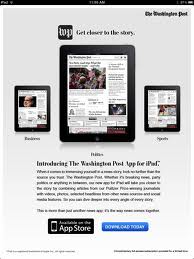As the famous Howard Gardner attests, we all have different areas of strength and different interests or “multiple intelligences”. Yesterday I gave a bunch of Washington Post newspapers to my students, they proceeded to DEVOUR it! One student was working away furiously on the soduku puzzle, two boys were reading the comics, two others were reading about the Washington Redskins, one girl was reading about the Emmy nominations in the Style section, you get the idea (one boy actually wanted to check stocks!). I had the students use their smart phones to download the Washington Post App and showed them a cute commercial promoting the Post’s app for the iPad.
When I circulated around the classroom not only were the students reading the paper version of the Post, but those who had apps were actually reading articles on their smart phones. The students that had iPads were interested in downloading the Post app and asked if they could bring the iPads in with the app on it. The newspaper whetted their appetite for world news, graphic stories (comics), puzzles, and other articles that they found interesting. Whatever the students were interested in, they read about, and as we know, the more a person reads, the better writer they become, test scores are higher and in general, we become more interesting , knowledgeable people.
I thought this commercial was really cute!


